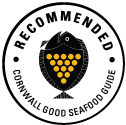

Beautiful tiger-stripes of black and green-blue are unmistakable. Mackerel is a delicious fish, closely related to tuna, its moist flesh is high in omega 3 oils and is best eaten when very fresh, barbequed, baked, or raw as sushi.
One of the best Cornish seafood choices, delicious, and very good for you. Cornwall's mackerel, the majority of which are handline caught, are sustainably harvested and very hard to beat. Stocks across Europe are in a period of slight decline but within Cornish waters industrial fishing targeting mackerel is banned. Small scale, inhore fishing vessels target mackerel with handlines, a selective and low impact method that produces the finest quality product. Small quantities are also caught as by catch in sardine ring netting and using gill nets. Best choice is handline caught.
In 2021 a total of 496 tonnes of mackerel were landed to Cornish ports with a value of £890k (MMO data).
Updated July 2023

Cornwall areas VIIe and VIIf
Mackerel handling is a low impact, selective method of fishing using hook and line.
Learn more
Cornwall
Gill nets are used during winter months on the south coast to target mackerel.
Learn more
Cornish waters VIIe, f, g and h
Ring nets are used to encircle a shoal of pelagic fish. the main target species are sardines and anchovies but occasionally there is a by catch of mackerel landed.
Learn moreCornwall Good Seafood Guide rates fish on sustainability using a scale of 1 to 5.
1, 2 and 3 are recommended, Fish to avoid are rated 5.
We use the system devised by the Marine Conservation Society (MCS) so our scores are comparable with the scores produced by MCS for the UK and fisheries from all around the world. For more information on scoring click here.
Mackerel are fast swimming, migratory, shoaling fish that range all around the North East Atlantic. They feed on plankton and small fishes and come into Cornish waters in huge numbers at certain times of year. Juvenile mackerel grow quickly and can reach 22cm after one year, and 30cm after 2 years. Mackerel can attain a maximum length of about 70cm and weight of 3.4kg.They may live for more than 20 years. By 3 years old, most mackerel are mature (at a length of approximately 28cm). Females shed their eggs in about twenty separate batches over the course of the spawning season. Mackerel are batch spawners, they spawn mainly in March to July; the eggs and larvae are pelagic. During this time spawning fish are not targetted as handlines only catch a small percentage of each shoal and only when they are feeding, not when they are spawning. Mackerel are moderately vulnerable to fishing effort, 44% (Cheung et al 2005).
Mackerel are managed throughout their range through an international agreement called the Coastal states agreement between the EU, Norway and the Faroe Islands.
Cornish mackerel stocks have been protected by the setting up of the mackerel box in the 1980's that still prohibits industrial scale fishing (pelagic trawling and purse seining) for mackerel in 67,000km2 of waters around the SW of England. 
The minimum landing size for mackerel within Cornish waters is 20cm.
Mackerel handline fishermen are given an annual quota which is a tiny share of the overall allocated catch of the members of the coastal states agreement.
Small quantities of mackerel are also landed as accidential by catch by Sardine ring netters. They are limited to a maximum of 15% mackerel.
A small fleet of day boats from Mevagissey fish for mackerel with gill nets. They switch to gill nets when the water is murky and handlines cease to work well. Due to risks of cetacean by catch in gill nets the gill net scores were reduced in 2022 affecting the overall rating of net caught mackerel.






Cornwall Good Seafood Guide is underpinned by the Marine Conservation Society (MCS) Good Fish Guide. The first UK consumer guide to sustainable seafood. For more information visit www.fishonline.org
Cornwall Good Seafood Guide is here to help us all make sustainable seafood choices. Choices that will help us keep the oceans healthy and Cornish fishers' futures safe. This website is funded by Cornwall Wildlife Trust. If you would like to make a meaningful difference to the health of our oceans, please consider making a donation to the Cornwall Wildlife Trust Ocean Emergency fund. Your donation will help safeguard these remarkable environments, ensuring that they continue to thrive for generations to come. Together, we can be stewards of the seas and champions for a healthier, more sustainable future.